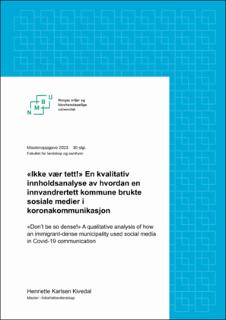| dc.contributor.advisor | Ruth Kjærsti Raanaas | |
| dc.contributor.advisor | Karin Winter | |
| dc.contributor.author | Kivedal, Henriette Karlsen | |
| dc.date.accessioned | 2023-07-15T16:27:32Z | |
| dc.date.available | 2023-07-15T16:27:32Z | |
| dc.date.issued | 2023 | |
| dc.identifier | no.nmbu:wiseflow:6839603:54592605 | |
| dc.identifier.uri | https://hdl.handle.net/11250/3079285 | |
| dc.description.abstract | Under koronapandemien hadde kommunene et ansvar for å formidle helseinformasjon til sine innbyggere. Denne formidlingen skulle nå en bred befolkning, inkludert personer med innvandrerbakgrunn, som var overrepresentert blant smittede og innlagte. Med sosial distansering fikk digitale kommunikasjonsformer en viktig rolle, og særlig sosiale medier. I lys av dette er det viktig å oppnå en god forståelse for hvordan disse kanalene ble brukt for å formidle helseinformasjon til en innvandrertett befolkning. I denne studien undersøkes det hvordan en norsk kommune har benyttet virkemidler som ligger til sosiale medier, og hvilke forventninger til mottakeren som kan tydes i kommunikasjonen.
Det benyttes kvalitativ innholdsanalyse av multimodale innlegg på sosiale medier fra en norsk kommune. De utvalgte innleggene er avgrenset til tidsperioden med nasjonale og lokale restriksjoner og tiltak, mellom 12. mars 2020 og 12. februar 2022. De utvalgte innleggene er hentet fra Facebook og Instagram. Fra disse to kanalene er det valgt ut totalt 351 innlegg som omhandler informasjon knyttet til pandemien, som så er analysert.
Det er gjort funn av syv ulike tema knyttet til forventninger som stilles til leseren. Disse temaene omhandler forventninger om innbyggere med lavere språk- og helsekompetanse og et behov for tydelig veiledning. Det er forventninger om innbyggere som er ansvarlige, selvstendige og digitale, som har engasjement i fellesskapet og en opplevelse av lokal tilhørighet. Det er også forventninger knyttet til innbyggernes tillit til autoriteter og fortrolighet med helsevesenet. Disse funnene er videre diskutert i lys av teori om kultur, språk, helsekompetanse og digital kompetanse.
Disse forventningene viser på den ene siden at kommunen bruker sosiale medier og de virkemidlene som er tilgjengelig til å tilrettelegge for lett forståelig helseinformasjon, men innbyggerne forventes også å ha høy grad av selvstendighet, helsekompetanse og digitale ferdigheter. Slike paradoksale ytterpunkter i hvordan kommunen henvender seg til leseren, kan indikere at deler av befolkningen som kanskje hadde hatt størst utbytte av helseinformasjon fra kommunen, likevel møtte barrierer. Forventningene som trekkes frem viser hvordan varierende forståelse av kulturelle erfaringer og referanser, språk- og helseforståelse og digitale ferdigheter, på samme tid både tilrettelegger for og hindrer denne gruppen i å nyttiggjøre seg av viktig helseinformasjon i krisetid. | |
| dc.description.abstract | During the Covid-19 pandemic, the municipalities had a responsibility to convey health information to their citizens. This information was meant to reach a broad population, including people with an immigrant background, who were overrepresented among the infected and hospitalized. With social distancing, digital communication took on an important role, and social media played a big part. Considering this, it is important to gain a good understanding of how these channels were used to convey health information to a population relatively densely populated by immigrants. In this study, it is examined how a Norwegian municipality has used tools available to social media, and what expectations placed on the recipient can be interpreted in the communication.
The chosen method has been a qualitative content analysis of multimodal posts on social media from a Norwegian municipality. The selected posts are limited to the time period with national and local restrictions, between March 12th 2020 and February 12th 2022. The selected posts are gathered from Facebook and Instagram. From these two channels, a total of 351 posts with information relating to the pandemic have been selected and then analyzed.
Seven different themes related to expectations placed on the recipient have been discovered. These topics deal with expectations of residents with lower language and health literacy and a need for clear instructions. There are expectations of citizens who are responsible, independent and digital, who have a commitment to the community and an experience of belonging to the local community. There are also expectations linked to citizens' trust in authorities and familiarity with the healthcare system. These findings are further discussed using theory about culture, language, health competence and digital competence.
These expectations show that the municipality uses social media and the tools available to facilitate easy-to-understand health information, but the citizens are also expected to have a high degree of independence, health literacy and digital skills. Such paradoxical extremes in how the municipality addresses the reader, may indicate that sections of the population who might have benefited the most from health information from the municipality, nevertheless encountered barriers. The expectations found in this study show how varying understanding of cultural references, language, health literacy and digital skills, both facilitate and prevent this group from making use of important health information in times of crisis. | |
| dc.language | nob | |
| dc.publisher | Norwegian University of Life Sciences | |
| dc.title | «Ikke vær tett!» En kvalitativ innholdsanalyse av hvordan en innvandrertett kommune brukte sosiale medier i koronakommunikasjon | |
| dc.type | Master thesis | |
